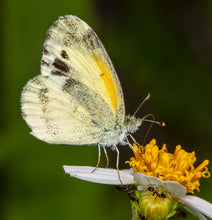Butterfly needles (Bidens alba) is an underappreciated workhorse in the garden. Also commonly known as Spanish needles, Sheperd's needles and beggerticks. It is a repeat bloomer with dainty white daisy-like petals surrounding tiny yellow flowers that bloom year-round in Florida. An annual or short-lived perennial herb that can grow as tall as 3-5' and 1-3' wide, Butterfly needles are great companions to dune sunflower (Helianthus debilis) and Purple coneflower (Echinacea purpurea). Perhaps more importantly, though, it's a plant with incredible importance to our native wildlife.
Butterfly needles tolerate full sun to partial shade and soil that ranges from moist to dry. If you are looking for a great filler plant that provides a wealth of help to our native pollinators, birds, and butterflies, why not add some to your garden? You can even grow it in a pot to help manage it if that is a concern. To thicken it to be more shrub like, simply sprinkle more seeds in the area you are trying to encourage their growth. The seeds do not really need much dirt to cover them, if any at all.
It is documented as having a very high value to our native bees and known as a Keystone plant since it supports so many wildlife species. This plant is also the 3rd most common nectar source in Florida for all of our pollinators as well as for honey production. It’s the caterpillar food source for Dainty Sulphur butterfly. Small birds like sparrows, warblers, finches and cardinals eat the seeds. The bearded dragons and tortoise at my nursery really enjoy the flowers and young tender leaves. Chickens also love it! And, according to at least one wild forager, the flowers make a tangy addition to salads – so they are edible for us! The entire plant is medicinally active, including the roots. known to have many medicinal properties as well that you can research that include fighting infections and viruses. Some of the antibacterial, skin infections, anti-inflammatory, diuretic, lower blood pressure, prevent liver damage and more.
/AC






